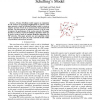49 search results - page 1 / 10 » Creating an adaptive network of hubs using Schelling's model |
CACM
2006
13 years 9 months ago
2006
Thomas Schelling's model suggests an explanation for the existence of segregated neighborhoods in America. This paper presents a study on utilizing Schelling's model to c...
CSUR
1999
13 years 9 months ago
1999
The Web can be naturally modeled as a directed graph, consisting of a set of abstract nodes (the pages) joined by directional edges (the hyperlinks). Hyperlinks encode a considerab...
WSC
2008
13 years 11 months ago
2008
Recent research has shown that while many complex networks follow a power-law distribution for their node degrees, it is not sufficient to model these networks based only on their...
JUCS
2010
13 years 4 months ago
2010
Abstract: One of the difficulties that self-directed learners face on their learning process is choosing the right learning resources. One of the goals of adaptive educational syst...
ISCAS
2002
IEEE
14 years 2 months ago
2002
IEEE
We have implemented an aspect of learning and memory in the nervous system using analog electronics. Using a simple synaptic circuit we realize networks with Hebbian type adaptati...

